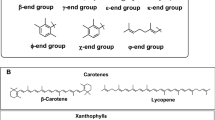Summary
A new type of oxygenases was isolated from plant and animal sources which oxidized pyrrole and indole derivatives. They had a broad substrate specificity and were called pyrrolooxygenases. Three different enzymes within the group were identified; skatole pyrrolooxygenase, tryptophan pyrrolooxygenase and porphobilinogen oxygenase. The first two oxidized the pyrrole ring of the various indole derivatives affording substituted o-formanidophenacyl derivatives as the main oxidation products. Tryptophan pyrrolooxygenase also oxidized the tryptophanyl residues of peptides and enzymes. When those residues were essential for the activity of the tryptophan containing enzymes, then inactive enzymes were obtained.
Porphobilinogen oxygenase oxidized porphobilinogen and related alkylpyrrole compounds affording 3-pyrrolin-2-one derivatives. The pyrrolooxygenases acted as mixed-function oxidases, since they required the presence of oxygen and of a reducing agent. The substrate, the oxygen and the reductant were consumed in equimolar amounts. The best artificial reducing agent was sodium dithionite. Illuminated active chloroplasts were the natural reducing agent of the plant enzymes and NADPH was the reducing agent of the animal enzymes. Pyrrolooxygenases were located in the chloroplasts of green leaves and in the microsomes in the case of the mammalian enzymes. The activity of the enzymes in the crude extracts was usually low, due to the presence in the same of a protein inhibitor. When the inhibitor was separated by protein fractionation methods, full enzymatic activity was recovered. Destruction of the inhibitor by aging or by temperature had the same effect. The very low oxygenase activity present in the microsomal rat liver preparations could be strongly enhanced by previous administration to the rats of phenobarbital or steroids. This induction of the oxygenase activity was coincident with a drop in the amount of inhibitor present in the extracts.
The properties and metabolic role of the pyrrolooxygenases are discussed.
Similar content being viewed by others
References
D. G. Irvine, W. Bayne, H. Miyashita and J. B. Majer, Nature, 224, 811–813 (1969); D. G. Irvine and L. Wetterberg, Lancet, 1201 (1972).
B. S. Deol, J. R. Alden, J. L. Still, J. Winkler and A. V. Robertson, Biochem. Biophys. Res. Comm., 47(6), 1378–1385 (1972).
J. Awruch and B. Frydman, Tetrahedron Lett., 2611 (1973).
G. B. Quistad and D. A. Lightner, Tetrahedron Lett., 46, 4417–4420 (1971).
E. Hoft, A. R. Katrizky and M. R. Nesbit, Tetrahedron Lett., 32, 3041–3044 (1967).
B. Witkop and H. Fiedler, Liebig's Ann. Chem., 558, 91–96 (1947).
R. Tenhunen, H. Marver, N. R. Pimstone, W. F. Trager, D. Y. Cooper and R. Schmid, Biochemistry, 11 (9), 1716 (1972).
F. Hirata and O. Hayaishi, Biochem. Biophys. Res. Comm., 47, 1112; and references therein (1972).
R. B. Frydman, M. L. Tomaro and B. Frydman, FEBS (Fed. Europ. Biochem. Soc.) Lett. 15, 305–308 (1971).
R. B. Frydman, M. L. Tomaro and B. Frydman, Biochim. Biophys. Acta, 284, 63–79 (1972).
R. B. Frydman, M. L. Tomaro, A. Wanschelbaum and B. Frydman, FEBS (Fed. Europ. Biochem. Soc.) Lett., 26, 1, 203–206 (1972).
G. A. Hamilton, Adv. in Enzymology, 32, 55–96 (1968).
D. M. Jerina, J. W. Daly, B. Witkop, P. Zaltzman-Nirenberg and S. Udenfriend, Biochemistry, 9, 147–156 (1970).
C. E. Dalgliesh, Biochem. J. 61, 334–337 (1955).
H. Kaseda, T. Noguchi, R. Kido and Y. Matsumora, Experientia, 26, 828–829 (1970).
H. Kaseda, T. Noguchi, N. Tonishi and R. Kido, Experientia, 27, 368–369 (1971).
R. B. Frydman, M. L. Tomaro and B. Frydman, Biochim. Biophys. Acta, 284, 80–89 (1972).
A. Patchornik, W. B. Lawson, E. Gross and B. Witkop, J. Am. Chem. Soc., 82, 5923–5927 (1960).
R. B. Frydman and B. Frydman, Arch. Biochem. Biophys. 136, 193–202 (1970).
R. B. Frydman and B. Frydman, Biochim. Biophys. Acta, 293, 506–513 (1973).
H. Holzer and W. Duntze, Annu. Rev. Biochem., 40, 345–374 (1971).
B. Peterkofsky and S. Udenfriend, J. Biol. Chem., 238, 3966–3977 (1963).
D. G. Irvine, W. Bayne and H. Miyashita, Canadian Fed. of Biol. Soc.; in press (1973).
F. De Matteis, Pharmacol. Rev., 19 (4), 523–538 (1967).
L. Kaufman, A. L. Swanson and H. S. Marver, Science, 170, 320 (1970).
Author information
Authors and Affiliations
Rights and permissions
About this article
Cite this article
Frydman, B., Frydman, R.B. & Tomaro, M.L. Pyrrolooxygenases: A new type of oxidases. Mol Cell Biochem 2, 121–136 (1973). https://doi.org/10.1007/BF01795467
Received:
Issue Date:
DOI: https://doi.org/10.1007/BF01795467




